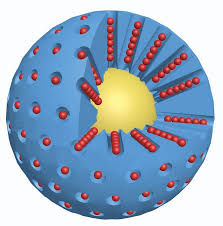Aromatic Molecules in Electronic Properties of SWCNTs (Based on Nano-Micro PhD) (PhD)
Researcher and author: PhD student : Afshin Rashid
Note: It is clear that carbon nanotubes have strong interactions with aromatic molecules such as graphite surface. SWCNTs can be considered as extended π-electron systems that can interact with other π- electron systems through π-π interactions.
Such π-π interactions act as the primary driving force for the adsorption of DNA and aromatic polymers onto the nanotube surface. It is interesting and important to discover how the selective interactions between π conjugates and SWCNTs occur. Certain aromatic monomers and polymers can selectively dissolve semiconductor or metal SWCNTs. The π-π bonding between the aromatic molecule and the surface of the SWCNTs occurs in a selective direction, which may be one of the reasons for the selective performance of these aromatic molecules. The selective noncovalent functionalization of semiconductor SWCNTs was characterized by porphyrin chemistry. Some aromatic molecules can form a charge transfer complex with metal SWCNTs.
Porphyrin chemistry has shown that some aromatic molecules can form a charge transfer complex with metal SWCNTs. Nano derivatives Fluorene polymer can be chosen to arrange nanotubes (7,5) and (8,6) and (10,5) to enrich themselves. T he polymer structure and solvent structure are both highly effective and in some cases lead to very high selectivity in terms of chiral diameter and angle . The acellular (Diles-Alder) condensation molecules are used to disperse high-diameter nanotubes . The selectivity of low-diameter nanotubes (<2.1 nm) is concentrated, while the choice of larger diameter nanotubes is concentrated.(nm 6.1 ~). Nanotubes of carbon semiconductor larger diameter (6mn) is the type of nanotubes yields better equipment, electronic. Large chiral nanotubes can be separated using dense benzoyd aromatics while small chiral nanotubes are separated by poly (polypropylene) derivatives. In addition, by controlling the dispersion-separation process, metal nanoparticles and then semiconductor nanotubes can be separated. Chiral diporphyrin isomers act as molecular tweezers to selectively isolate right-handed or left-handed SWCNTs . Chiral selectivity with two-way angle control between porphyrins Optimized. It is interesting that diporphyrin molecules can deform or deform before they can detect electron scattering by correcting the error of the carbon network in space. This makes the index more reliable separation of chiral nanotubes do
Conclusion :
The advantage of using aromatic molecules is their structural diversity and their similarity to nanotubes. Molecules can be designed and synthesized to make the precision of further separation operations non - discriminatory . Generally, two important points in relation aromatic molecules and bond covalent there nanotubes SWCNTs of different absorbed by the molecules to be performed and another distribution SWCNTS intensified the attraction is. Therefore, in these non-quantitative methods, the separation efficiency is always affected by the solvents .
Author: Engineer Afshin Rashid
PhD student of Nano-Microelectronics at Islamic Azad University, Science and Research Branch, Tehran




